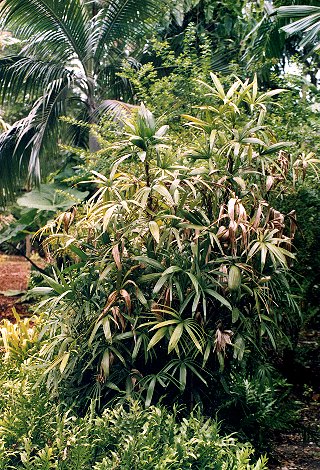Rhapis subtilis
Scientific Name: Rhapis subtilis

Min. Temperature: 27°F (-3°C)
Water Requirements: Regular water
Sun Requirements: Light shade to shade
Origin: Thailand
Leaf: Palmate
Trunk:
Flower:
Fruit:
Seed:
Rhapis subtilis is the other fairly commonly seen species of Rhapis. At less than 2.5 metres mature height this species is easily distinguished from Rhapis excelsa by its smaller size at maturity. Rhapis subtilis has canes that are less than 15mm in diameter and smallish leaflets that are thin in section. Leaflets are also pointed whereas Rhapis excelsa usually has blunt irregularly toothed ends as regular segments of approximately the same width with corresponding leaves having roughly the same number of leaf segments (e.g. if one leaf has seven leaflets the leaf immediately above or below it will have either six or eight leaf segments). Whereas Rhapis subtilis has a varying number of leaf segments with varying widths. Rhapis subtilis is almost always grown from seed and it forms a fairly even, rather compact central clump of thin canes with suckers developing close to each other. On the other hand Rhapis excelsa is usually grown from division of offset suckers which spread laterally as sometimes long cane-like rhizomes. These differences in growth habit can be used to help to roughly determine which of the these two species you have at home. However this general guide is not always reliable since I have a palm which I believe to be Rhapis subtilis, but it is just over two metres high in a pot, has canes that are up to 25mm in diameter, leaves are relatively small, leaf segments are irregular in number and width and thin in section. R. subtilis is a dioecious multi-stemmed palm that grows to a maximum height of around 2.5 metres. Stems or canes are very slender usually around 10mm in diameter although some plants may have broader canes. As with Rhapis excelsa, canes are dark green, have closely spaced leaf base scars and are covered with fibrous leaf sheaths. Fibres on leaf sheaths are fine and closely adhere to the canes, giving canes a slender rather neat appearance. Leaves are palmate, dark green, thin textured and divided into few to many irregular segments that are divided to the centre of the leaf. Each leaflet is multiribbed, pointed and minutely toothed on outer and inner margins. Mature plants have from two to nine leaflet segments per leaf. The leaf blade can be from 200mm to 400mm across arranged in a semi-circle. Petioles are slender and wire-like up to 300mm long although usually shorter and sparsely covered with fine fluffy hairs. Leaf sheaths may be up to 300mm long, the edges of which have light brown fine fibres, that closely enwrap the canes. Inflorescences are interfoliar, arising from within the upper leaf sheaths and is enclosed in brown papery bracts. The branchlets are green stiff and rather brittie, branched to second order, and fairly upright in habit. Flowers are arranged irregularly along the angular branchlets. As very few of my plants have flowered I have not observed their flowers in detail but from a fruiting plant I purchased from Queensland fruits are greenish maturing to light brown, spherical, 3 to 6mm across. Culture for R. subtilis is fairly similar to R. excelsa except that R. subtilis is tropical in its requirements. Cold weather may damage foliage particularly if the cold persists for a long time. The plants require shade and under shelter will not be damaged by cold nights even down to about -4° C. R. subtilis also requires more regular watering than R. excelsa, water so that the soil is moist but not wet. Even with plenty of water the plants may still suffer from burnt leaf tips especially when grown in containers. This palm suffers from one pest that does not affect R. excelsa, and that is spider mite, especially on plants that are grown indoors in warm dry atmospheres. Spider mite can be easily controlled by regularly spraying upper and lower leaf surfaces with soapy water or if you want quicker results thoroughly spray foliage with a miticide such as Kelthane, Dimethoate or similar and it is necessary to alternate miticides since mites are notorious for building up resistance to one chemical.
![]()
Desert Tropicals Home Page | List of All the Plants | Check for more members of the Arecaceae family
© 1998-2020 Philippe Faucon, All Rights Reserved.